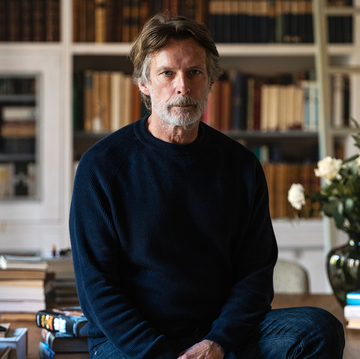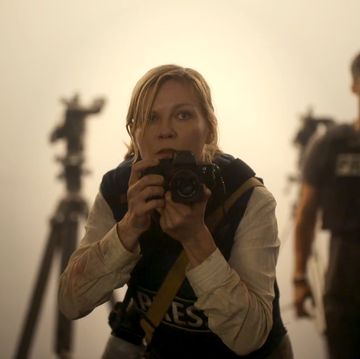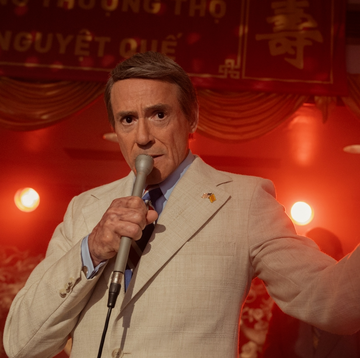On the seventh floor of an office block in midtown Manhattan a meeting is taking place. Sales and marketing co-ordinator Sarah Dominguez is showing half a dozen of her colleagues photographs for a new advertising campaign, one that will take their brand through the important holiday season, from Black Friday to Christmas Day.
"It's Bigfoot. It's Sasquatch," suggests someone.
"It's a modern-day… what's that Sesame Street character?" asks Jonathan Levine, the founder and CEO.
"The Grouch," says someone.
The photographs are of a six-foot man in a ghillie suit, emerging from a subway station and wandering around SoHo, the shopping district known for its designer boutiques and fancy chain stores. The camouflage character has been chosen to tie-in with a new product line, camo-patterned headphones. We are in the offices of Master & Dynamic, the high-end audio brand, who in three years have broken into a hugely competitive market to become one of the most distinctive and talked-about names in designer tech. It is the first time they have launched an ad campaign to speak of, one that will go under the slogan "A World Apart". The new headphone collection is called Greene Street: this afternoon people employed on SoHo's actual Greene Street will be photographed wearing them.
"There's some really cool brands there," someone says. "Stone Island, Acne…"
"Some of our competitors are on Greene Street, like Devialet and Sonos."
"Beats used to be," Levine says.
Talk turns to a pop-up shop, to be designed by Green Fingers ("This is like a triple-entendre"), the Tokyo creative company that specialises in designing concrete-and-foliage environments for trendy fashion retailers, including Mr Porter and Adidas.
"I'll share with the team the rough social calendar," says Dominguez. "But we're really trying to push that super-visual element. The bigger umbrella of not just having an Instagram calendar, but Twitter, blog, Facebook and emails. So: all together. Hopefully, November will be a good roll-out."
Apart from Levine and his co-founder Vicki Gross, the meeting is comprised of casually dressed millennials, and the mood is upbeat and jovial on both sides.
"Anyone else want to compliment me?" asks Levine, after someone thanks him for setting up some brainstorms with retailers.
"Well done for attending a meeting?" suggests Gross.
"And actually paying attention?" chuckles Levine, who has been fiddling with his laptop throughout. "Sort of."
The story goes that Levine, a former Wall Street commodities trader turned successful entrepreneur, whose previous businesses include making a plug to convert DC to AC current from car cigarette lighters to charge phones, power tools and battery-operated LED lighting, turned to headphones after building a recording studio in his office so he could spend more time with his music-mad son Robert, following a divorce. Robert had handed down his Beats by Dr Dre headphones to his younger brother Justin, finding them both sonically underwhelming and too ubiquitous for DJing. (Justin subsequently gave them away.) Levine, who studied architecture and has an eye for luxury and design — he favours Common Projects trainers, Ermenegildo Zegna shirts and watches by A Lange & Söhne, Rolex and IWC, and keeps a Twenties coin-operated football table in his office — chanced across a pair of WWII aviator headphones in a Washington DC museum. Because they were made from leather and metal, they had aged well and, to Levine at least, looked modern, even timeless.
Melt down most sets of headphones and you're left with a tennis ball-sized lump of plastic. Nothing very luxurious about that. But what if you went the other way, Levine wondered, and constructed them from lambskin and anodised aluminium? Could this be a gap in the market? In 2013, Levine asked his fledgling team to forget they were starting a headphone company: if they were a camera, watch, luggage, car, coffee or fragrance brand, who would they be? (They settled on Leica, IWC, Rimowa, Aston Martin/Tesla, Nespresso and Frédéric Malle.)
Master & Dynamic was launched in May 2014 with an initial product line comprising two headphones and one earphone. The flagship model MH40s were distinctive: they looked like WWII aviator headphones. Marketed to the creative community as "sound tools for creative minds", and sold into fashion boutiques like Opening Ceremony in New York and Colette in Paris, they retailed for £370 and received universally positive reviews from the audio and tech press. Where the market was split into performance products for at-home audiophiles and fashion-led lines for a younger, out-and-about crowd, Master & Dynamic hit a note right in the middle. They satisfied geek and chic. The brand has subsequently collaborated with Leica, Aston Martin, Bamford Watch Department and Ermenegildo Zegna. In 2017, it launched a wireless speaker for the home, co-designed with the British architect Sir David Adjaye. Made of proprietary concrete composite and cast in a slab-like "new geometric form", it forewent the traditional box-shape of almost every other speaker, weighed 16kg and retailed for £1,600.
"I didn't enter this business with a golden Rolodex of connections in the industry," the boyish, likeable Levine tells me. "I'm not the former CEO of another audio brand. I'm not from the music industry, like other famous, or well-known, entrepreneurs. And I'm not the former CEO, founder or head of marketing for another luxury brand. My only connection to luxury is being a luxury consumer. But somehow at this age, I've been able to synthesise it all together, and connect the dots. Luckily, I have a lot of energy. That's important for any entrepreneur. And I enjoy meeting people."
This is true. During our time together Levine mentions, in passing, friendships with the president of Rolex North America, the boss of Moncler, the head of British design studio Andrew Winch and the CEO of Baccarat Crystal. One morning I arrive to find him on the phone to the marketing director of Feadship, Dutch makers of custom superyachts. Not long ago he found himself in Abbey Road Studios, watching Frank Ocean. Back in New York he chanced upon Paul McCartney promoting something in a department store. Levine introduced himself and showed him the photo he'd taken in The Beatles' famous recording studio. He'd welcome the opportunity to make some headphones for McCartney. Macca thanked him but being vegan, lambskin wasn't for him. Levine duly went off and partnered with Alcantara, producers of the suede-like synthetic material found in Formula One cars, to make an animal-friendly version now in Master & Dynamic's range.
In addition, Levine is a fixture at events such as Salone del Mobile Milano, the Milan furniture fair. When we meet he has just got back from the Monaco Yacht Show, not, as one member of staff explains, because he wants to buy a yacht but because this is where the high-net worth people hang out and because he wants to get a feel for where he should be and whom he should talk to.
"He has big dreams and his enthusiasm is infectious," a former employee who worked on the brand's launch tells me. "He's a real people person and he's got a real knack for connecting with a broad spectrum of characters."
That includes his customers. Anyone emailing the standard "info@" or "support@" addresses with a query has a chance of getting an answer from Levine himself.
"They love the fact the CEO is emailing them on a Saturday," he beams. "When I see somebody, could be in an airport, on a plane, in a subway, wearing my headphones, I'll go up to them, and I'll say, 'Excuse me' — obviously they'll have to take their headphones off — 'Where did you get the headphones?' They'll say, 'What?' I'll ask again, 'What headphones are they?' Then they'll reply, 'Oh, Master & Dynamic, I got them blah blah blah.' I'll ask, 'Are they any good?' They'll reply, 'Yeah, they're amazing, the best headphones I've ever had.'"
"Then I'll ask, 'Excuse me: what do you do for a living?' I would say 95-plus per cent turn out to be in advertising, design, architecture, fashion. This is very interesting. If you think about it, we've created this company based on the creative community and engaged with them, and it seems to be working."
When does he say, "It's my company"?
"I say, 'Do you know what I do?' They say 'No', and I give them my card. And they go, 'Ahhh!'"
Dressed in a black leather tracksuit and blue tinted sunglasses and accompanied by young women in pastel Lycra bodysuits, Cliff Richard roller-skates through Milton Keynes' shopping centre. It is 1981 and you are watching the video for "Wired for Sound". Strapped to Richard's waist is the newly released Sony Walkman TPS-L2, a 1lb portable cassette player with chunky buttons and a leather case. Around his neck are the accompanying headphones, lightweight foam-covered earpieces connected by a thin metal band. Having been stung by the failure of its Betamax video recorder, the early Eighties found Sony in need of a hit. It gambled on a personal cassette player with no external speaker. To cover their backs they included two headphone jacks, lest the idea of listening to music alone and in public was deemed too weird or antisocial. The combination of portability (it ran on two AA batteries) and privacy (it coincided with the aerobics craze, and was attributed to a 30 per cent rise in people exercising by walking) turned it into the accessory of the decade.
Predicted to sell 5,000 units a month, it cleared 50,000 in its first two and by 1983 cassettes outsold vinyl for the first time. Today an original Walkman is displayed in London's Design Museum. Sony had done something incredible: we could now take ownership of our own audio space. Or as Michael Bull, professor of personal sound studies at the University of Sussex, later put it: "Privatised and mediated sound reproduction enables consumers to create intimate, manageable and aestheticised spaces in which they are increasingly able, and desire, to live."
Sony had also created the first wearable, long before fitness trackers. But it didn't come up with the headphone. For that we have to thank Thomas Edison, who in 1877 concluded five days and nights working away on his phonograph by listening on his own original set. By 1881, the Théâtrophone, which used telephone lines to pipe music directly into people's homes, launched in Paris, to be followed by London-based company Electrophone, who introduced headsets that allowed well-off listeners to hear performances from the Royal Opera House via a switchboard.
The modern headphone was invented in 1910 by Utah's Nathaniel Baldwin, who wanted to amplify the sound of sermons at his local Mormon temple. Baldwin's headphones contained a mile-long coil of copper wiring in each earcup, and is now the basis for the larger cup shape we recognise and know today. His design took off when the US Navy used them in WWI. By the Sixties, the brand Koss developed both noise-blocking cups for pilots and the first pop star co-brand: Beatlephones with stickers of the Fab Four on each enamel cup.
The birth of today's headphone culture comes, of course, from Apple. The iPod arrived in 2001, launching with the promise of "1,000 songs in your pocket" and its distinctive dancing silhouettes ad campaign. The star of these adverts wasn't the consumer or the device, something Steve Jobs initially hated, it was the high-contrast white earbuds and cable, soon to be blamed for a rise in muggings and — quaint now, given smartphones — hysteria over "iPod zombies". For the first time since the Walkman, headphones became a fashion statement. In 2013, Roksanda Ilincic and her backstage team wore Sennheiser's Momentum On-Ear headphones during the unveiling of the designer's SS '14 collection at London Fashion Week. A year later, Karl Lagerfeld launched Chanel's Monster headphones at Paris Fashion Week (later sold in stores for £4,170), and in 2015 Dolce & Gabbana partnered with Frends to show off headphones festooned with Swarovski crystals at Milan Fashion Week.
As music became free, as our smartphones became the conduit for Spotify, YouTube, Netflix, podcasts and video games, as the amount we were willing to pay for entertainment evaporated, the amount we were willing to spend on the hardware to play it through increased. HMV moved music to the back of its stores and headphones to the front. Today, practically everyone in the UK owns some sort of personal audio player. They all need headphones. The concern in 2001 over being mugged for your £399 5GB iPod now seem laughable. Today, that's a reasonable entry-point for any number of headphone brands — Bose, Bowers & Wilkins, B&O Play, Sennheiser. The market is predicted to be worth over £14bn by 2022.
"Audiophiles have always been willing to spend a huge amount of money on headphones," says Toby Jarvis, client insight manager at retail analysts GfK. "But with advances in technology like noise-cancelling, which is good for commuters, and wireless, which now accounts for half the market, there are tangible benefits. A lot of innovation is for innovation's sake. This improves people's day-to-day. Bose have launched a version of their QuietComfort 35 II with Google Assistant, there's a lot of hype around voice tech. Apple's new AirPods have been significant, too. The market is extremely positive."
For this, we must thank Dr Dre. The way he and his business partner, music mogul Jimmy Iovine, saw it, a decade ago the music business faced two problems. Loss of music sales through piracy and loss of music quality through Apple's earbuds. "Apple," Iovine noted, "was selling $400 iPods with $1 earbuds. Dre told me, 'Man, it's one thing that people steal my music. It's another thing to destroy the feeling of what I've worked on.'"
Technology, he figured, was the new artist. If Steve Jobs had created a premium white object with all the music in the world on it, he and Dre would make a premium black object to play it back, and "market this product just like it was Tupac or U2 or Guns N'Roses". Helped by endless music video placements and endorsements from athletes — the entire US basketball team showed up to the 2008 Olympics in Beijing wearing them — Beats by Dr Dre became a status symbol overnight. Over-ear "cans" were no longer the preserve of audiophiles. They were streetwear.
Apple acquired Dre's company three years ago, turning their namesake, as he has hardly shied away from pointing out, into hip-hop's first billionaire. Today, Beats By Dr Dre account for an incredible 70 per cent of the premium (over £100) headphone market. Ironic, since reviews of their products have often been less than premium: complaints of shonky construction, poor value for money and a tuning that pushes bass at the expense of everything else are commonplace.
"Just as we were getting ready to launch, the rumours of Apple buying Beats came out," Levine says. "I can't tell you how many people I had reaching out to me saying 'Are you OK? This can't be good for you.' For 24 hours I was a bit unnerved because it was big, big news. But then I realised Beats was not our core competition. It was really the other companies.
"I literally think the best thing that happened to us was Apple buying Beats. Anytime there are one or two brands that dominate a category, that's easier to compete in, rather than everything being flat. If 20 people have five per cent of the market, it's hard to differentiate and figure out how you're going to grab a few percentages. But when one or two players have 50 or 60, or whatever the numbers are, I think it's easier. If it wasn't for Beats I wouldn't have entered the category, because it shows you can compete with something new. Pretty much every company that tried to become 'the next Beats' by competing with Beats doesn't exist because people say, 'Why would I want that copy of Beats, when I can go and buy the real Beats and feel good about it?'"
Still, I suggest, it can't have been the easiest market to go into. It's not like the world was crying out for another headphone brand.
"It's funny," he says. "Before we launched, friends and family would ask what I was up to. Everybody, even eight months after we launched, said, 'Why would you get into headphones? It's so competitive.' I'd answer I don't know of any category, whether a service or product, that's not competitive today. Real estate, restaurants, you name it. And so my premise was: 'Listen, if you have something special, you should compete. If you don't, you should probably do something else.' After a year, I realised nobody had asked me that question. They started to see what we were doing was different."
Master & Dynamic's early promotional material touted their products as the "modern thinking caps", a fairly horrendous phrase, but they were onto something. While others targeted a young, sporty, clubbing crowd, Master & Dynamic went professional. Offices had become more open-plan and informal: headphones are accepted, even necessary, to concentrate. (And that's if your office is an office, and not a Starbucks.) A professional-looking set of cans you can keep at your desk is a nice thing. There are few more distressing sights in modern life than a grown man wearing a suit and a pair of bright red plastic headphones.
In the corner of Master & Dynamic's offices is "The Lab", where it develops new products. One afternoon, Levine sits down for a meeting with Drew Stone Briggs, chief product officer and an early recruit from rivals Bose, and product designer Thomas Wilson. They have a number of projects on the go. But first, conversation turns to a rival's latest release, reviews of which have been published that morning. They have not been kind.
"Another one for those guys, huh?" says Levine, behind his laptop.
"Two mediocre reviews and one that was, wow, brutal," says Wilson.
"PCMag was just… yeah," says Stone Briggs, shaking his head.
"How do you make a small fortune?" says Levine, teeing up the joke with the punchline "start with a large one and invest poorly".
"Start a headphone company?" teases Stone Briggs.
They whip through the update, presenting mock-ups on a screen. First, some new technology to incorporate into an existing line. The design alterations required are imperceptible to me, but Levine is forensic.
"Black on black might work," he frowns. "But I feel there's a lot going on there."
"Yeah," agrees Stone Briggs. "It's messy."
Next, a modification to the Sir David Adjaye speaker. Its concrete composition might be groundbreaking, but it also exposes its woofer and tweeter — the latter being a 1.5in disc of woven kevlar that some have found too irresistible not to prod. "Even for adults it's, like, 'What is that shiny…?'" says Stone Briggs, before presenting some options for a thin titanium guard.
Finally, there is a new product, at the functional prototype stage, which in 2018 will solidify Master & Dynamic's commitment to wireless. They pass around design options.
"We're thinking this is quite feminine and unique, and this can be quite masculine and also interesting," says Drew Briggs. "And this could be, like, out there. Maybe a special one-off for a special customer, or a fashion collaboration." "It's cool," he says. "We're in uncharted territory right now."
In the Master & Dynamic offices, PR Christine Doh is known as "the gifting goddess". Master & Dynamic have never done a celebrity endorsement. They don't do product placements. You won't find famous people in their Instagram feed. Instead they rely on what Levine calls "strategic word-of-mouth". This translates as supplying the right people and events with the right product and believing they'll do the rest. One musician both Levine and his sons agree on is André 3000 ("I created a playlist with my eldest son and he's, like, Jay-Z and Kanye, and I'm, like, Van Morrison and Warren Zevon," Levine says) often photographed out and about with his Master & Dynamic MH40 over-ears. But Levine has forbidden his PR department to make anything of this. It seems a little counterintuitive.
"It does. But people in the luxury world, CEOs of luxury brands, actually say, 'That's exactly what you should be doing, that's actually cooler, that's the right thing.' If you look at the feeds of some these brands that we love, Gucci, Moncler, they've earned the right to do that. But I cringe to think we'd use that in our marketing. I think it's better for these people to be seen, and to market ourselves privately. It almost becomes an inside secret. Like, 'Oh, how did you get those?'"
That's a long-term strategy.
"And I'm a guy, at 55, thinking long-term," Levine says. "But if you look at the companies I wanted to compete against early on, these are companies that were started between 1945, Sennheiser, and 1964, Bose. Those brands are still strong and relevant and have a healthy business. So if I can build Master & Dynamic into a brand that is still important in 50 years, that's what I set out to do. To create a product, that in 50 years, someone would buy on eBay, or their version of eBay, and say 'Oh my God, look at those things.' And put them in their office, or their home. As an object of beauty."
That evening, Levine and Gross have arranged to attend a talk at the Museum of Modern Art. It is by Paola Antonelli, curator of an exhibition called Items: Is Fashion Modern? which has just opened. They invite me along.
"She's been good to us, so we should support her," Levine explains. "They took our speaker in the MoMA gift shop. Do you know how difficult it is to get something in there?"
Have they sold any? A 16kg concrete speaker is a different proposition to a Warhol pen or a Lichtenstein tea towel, after all.
"Yeah," Levine grins. "We made the world's most non-portable, portable speaker."
After the talk, we walk round the exhibition of 111 designs MoMA deems to have changed fashion. These are listed on a wall-sized display at the entrance: Adidas Superstars, Bucket Hat, Biker Jacket, Little Black Dress, Loafer, Swatch, Tracksuit, and so on.
Gross spots one other: "Headphones."
We predict which headphones. There, in a case, opposite Hermès' Birkin bag and Yves Saint Laurent's Le Smoking tuxedo, is Sony's original Walkman, plus foam headset.
"They're beautiful in their simplicity," Levine marvels. "One day. I mean, all things are possible, right?"
Master & Dynamic employs around 35 people (Beats has some 700). It was started with Levine's money, having never raised a penny of outside capital. Was that scary?
"It's still scary," he says. "But I remember going to [business] conferences and seeing a company who were very proud, they had banners that said, 'We've raised $135m from…' with five very prominent VC investment companies listed, and their thinking was almost like, 'If you raise a lot of money from the right people, you're guaranteed success.' That's complete nonsense. Why we love working with brands like Zegna or Leica, and we're starting to do stuff with the watch industry and aviation, too… it's great for co-branding, but you also get to learn from these people. How they built their brand, and how they treat it. I think if we'd taken on early investment from VCs it probably would have pushed us in the wrong direction. Because what happens is, you have a grand plan and sometimes that doesn't go to plan, the market is changing, retail is changing, and then investors say 'Wait a minute, you've got to do this now, so that you can grow.' All of a sudden you have a very different company from what you started with. So being private is absolutely part of our magic."
Levine's father died when he was four. He took his role as the eldest son, the male of the house making his own way and supporting his family, seriously. "A hustler all the way," he smiles. "All legitimate."
"Every time I go places, there are opportunities I've created, just by meeting people. It's that curiosity, and a bit of scrappiness. We know we have to work harder in this competitive world where we are competing against giants. We have to think and act like underdogs. You have to be out there. And it's never failed me."
The last time I see Levine, he and the team are off on a night out. It is the Surface magazine travel awards and Master & Dynamic's collaboration with Zegna has won in the best headphones category. Before that Levine wants to meet me in the West Village to show me the new Chrome Hearts store. The LA-based brand is noted for its high-end jewellery, rock 'n' roll clientele and penchant for rendering household objects in solid silver and diamonds, with suitably adjusted prices. The cavernous 16,000sq ft venue has only just opened: apparently taking five years of development to get to a point where owners Richard and Laurie Stark were happy. Inside is a two-storey gallery space, showroom, shop lounge and chef's kitchen. Everything for sale is one-of-a-kind, including a 14-seat dining table, 13ft stuffed leather dinosaur with sterling spikes and a 70kg chainmail American flag with pavé diamonds.
Levine introduces me to Stephanie Reynolds, Chrome Hearts' PR: "The most important person in luxury right now."
We get given the tour. "The everyday stuff is actually some of our best-sellers," Reynolds explains. "The pizza cutter, carrot peeler, baseball bat. Richard likes to he say he makes everything in the whole wide world, he just hasn't been around long enough yet."
I pick up a toilet plunger. It comes in two options: $1,300 without diamonds, $10,000 with. Then there are the plastic ketchup bottles, red and yellow, familiar to anyone's who's ever been in a diner. Except these ones have pavé lids and cost $40,000.
Before he leaves Levine writes a note to Lynne Sable, Chrome Hearts' sales director, leaving her two sets of headphones from an upcoming but unreleased Master & Dynamic collaboration with a tattoo artist famous for his Hollywood clientele.
"Just something to try and get me closer to my Chrome Hearts collaboration," he tells Reynolds. "She's so tough! We're a very new brand. It's, like, 'Get in line…'"
Back outside Levine is overcome with admiration. "It's fucking nuts," he says. "Seriously. I feel good about the stuff I've created, then I go in there and I'm, like, 'I've got to up my game.' Fantastic."
The Starks started their business in 1988.
"OK," he says, clapping his hands. "I've got 20-something more years to get this right."
In an Uber on the way to the Surface party word comes that the awards will be presented by Solange Knowles. Levine jumps on his phone. "Can we get a pair of headphones sent over for her?"














